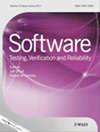一种基于模糊的测试创建方法,用于通过传输流评估数字电视接收器
IF 1.2
4区 计算机科学
Q3 COMPUTER SCIENCE, SOFTWARE ENGINEERING
引用次数: 1
摘要
数字电视(DTV)接收机通常提交测试系统进行一致性和稳健性评估,其批准意味着在给定的数字电视规范协议下正确运行。然而,许多广播公司无意中错误地配置了他们的设备,并传输了有关数据结构和协议格式的错误信息。由于大多数接收器的设计不适合在这种条件下工作,因此可能会注意到故障和不正确的行为,通常被认为是现场问题,从而危及给定系统的操作。此外,通常在数字电视信号中引入这些问题的方式呈现出一些随机性,但是在数字电视系统中使用的底层传输协议给出了已知的限制,这类似于模糊技术。实际上,任何事情都可能发生,因为任何偏差都可能导致问题,这取决于每个特定的实现。本文解决了这种错误情况,并提出了一种新的基于非符合性测试的接收器鲁棒性评估方法,该方法使用基于语法的引导模糊测试。特别是,设备被提交到不可预见的条件和不正确的配置。它们是根据实际问题、协议结构、系统架构,通过引导模糊来创建的,为处理它们提供资源,从而保证正确运行。使用这种模糊方案的实验表明了它的有效性,并为提高商业数字电视平台的鲁棒性提供了机会。本文章由计算机程序翻译,如有差异,请以英文原文为准。

A fuzzing‐based test‐creation approach for evaluating digital TV receivers via transport streams
Digital TV (DTV) receivers are usually submitted to testing systems for conformity and robustness assessment, and their approval implies correct operation under a given DTV specification protocol. However, many broadcasters inadvertently misconfigure their devices and transmit the wrong information concerning data structures and protocol format. Since most receivers were not designed to operate under such conditions, malfunction and incorrect behaviour may be noticed, often recognized as field problems, thus compromising a given system's operation. Moreover, the way those problems are usually introduced in DTV signals presents some randomness, but with known restrictions given by the underlying transport protocols used in DTV systems, which resembles fuzzing techniques. Indeed, everything may happen since any deviation can incur problems, depending on each specific implementation. This error scenario is addressed here, and a novel receiver robustness evaluation methodology based on non‐compliance tests using grammar‐based guided fuzzing is proposed. In particular, devices are submitted to unforeseen conditions and incorrect configuration. They are created with guided fuzzing based on real problems, protocol structure, and system architecture to provide resources for handling them, thus ensuring correct operation. Experiments using such a fuzzing scheme have shown its efficacy and provided opportunities to improve robustness regarding commercial DTV platforms.
求助全文
通过发布文献求助,成功后即可免费获取论文全文。
去求助
来源期刊

Software Testing Verification & Reliability
工程技术-计算机:软件工程
CiteScore
3.70
自引率
0.00%
发文量
34
审稿时长
>12 weeks
期刊介绍:
The journal is the premier outlet for research results on the subjects of testing, verification and reliability. Readers will find useful research on issues pertaining to building better software and evaluating it.
The journal is unique in its emphasis on theoretical foundations and applications to real-world software development. The balance of theory, empirical work, and practical applications provide readers with better techniques for testing, verifying and improving the reliability of software.
The journal targets researchers, practitioners, educators and students that have a vested interest in results generated by high-quality testing, verification and reliability modeling and evaluation of software. Topics of special interest include, but are not limited to:
-New criteria for software testing and verification
-Application of existing software testing and verification techniques to new types of software, including web applications, web services, embedded software, aspect-oriented software, and software architectures
-Model based testing
-Formal verification techniques such as model-checking
-Comparison of testing and verification techniques
-Measurement of and metrics for testing, verification and reliability
-Industrial experience with cutting edge techniques
-Descriptions and evaluations of commercial and open-source software testing tools
-Reliability modeling, measurement and application
-Testing and verification of software security
-Automated test data generation
-Process issues and methods
-Non-functional testing
 求助内容:
求助内容: 应助结果提醒方式:
应助结果提醒方式:


